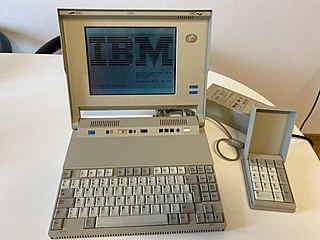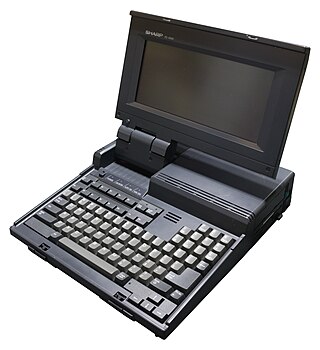
The IBM Simon Personal Communicator is a handheld, touchscreen PDA designed by International Business Machines (IBM), and manufactured by Mitsubishi Electric. Although the term "smartphone" was not coined until 1995, because of Simon's features and capabilities, it has been retrospectively referred to as the first true smartphone.

The LTE is a line of notebook-sized laptops manufactured by Compaq Computer Corporation, introduced in 1989 and discontinued in 1997. It was the first notebook computer sold by Compaq and the first commercially successful notebook that was compatible with the IBM PC.

The history of laptops describes the efforts, begun in the 1970s, to build small, portable Personal Computers that combine the components, inputs, outputs and capabilities of a Desktop Computer in a small chassis.

The IBM Personal System/2 Model L40 SX is a laptop made by IBM as part of the IBM PS/2 series. It was the successor to the IBM PC Convertible. The "SX" in the name refers to its CPU, the Intel 80386SX.

The LTE Lite was a series of notebook-sized laptops under the LTE line manufactured by Compaq from 1992 to 1994. The first entries in the series were Compaq's first computers after co-founder Rod Canion's ousting and Eckhard Pfeiffer's tenure as the new CEO. The notebooks were co-developed and manufactured by Compaq and Citizen Watch of Japan. They were a hot-seller for Compaq and spanned multiple models, with various processors and liquid-crystal display technologies.
The Eazy PC is an all-in-one IBM PC compatible computer manufactured by Zenith Data Systems (ZDS) starting in 1987. This small-form-factor XT-compatible system has some distinctive features, such as using an NEC V40 CPU. The Eazy PC was designed to be a simple, cost-effective computer for the home. This was a departure for ZDS, who had historically avoided the retail consumer market to focus on customers such as businesses, universities, and government agencies.

The ActionNote was a series of notebook-sized laptops developed by Epson America in 1993. The series was Epson's answer to the small businesses and home office market for laptops and initially ran alongside their corporate-oriented NB series of laptops. The series was segmented into premium and low-cost offerings and included a subnotebook, the ActionNote 4000. The bulk of the laptops' manufacturing was performed by ASE Technologies of Taiwan, with the exception of the 650 and 660 series, which were produced by Compal, and the short-lived initial entries into the 700 series, which were produced by Jabil Circuit. The ActionNote received mixed, mostly positive, reception in its lifespan before Epson America silently left the personal computer market in 1996.
The PB286LP, released in 1989, was Packard Bell's first laptop computer. The laptop featured an 80C286 processor clocked at 12 MHz and 1 MB of RAM, along with a single ISA expansion slot. Packard Bell released the PB286LP in 1989 among a slew of products aimed at the corporate market. Technology writers gave it mostly positive reviews, although some noted its 16-lb weight as hefty and its monochrome LCD as somewhat flawed. Originally only capable of CGA-mode graphics, the laptop was updated in 1990 to support VGA. Packard Bell discontinued the PB286LP in 1991, in favor of more-compact, notebook-sized computers.

Canon Computer Systems, Inc. (CCSI), sometimes shortened to Canon Computer, was an American subsidiary of Canon Inc. formed in 1992 to develop and market the parent company's personal computers and workstations. The subsidiary also assumed the responsibility of marketing Canon's printers and photocopiers, which were formerly sold by other Canon divisions. It went defunct in January 2001.

DTK Computer is the name for international branches of Datatech Enterprises, a Taiwanese computer manufacturer. Founded in 1981, the company was an early supplier of peripherals for IBM PCs as well as PC compatible motherboards. In the late 1980s, the company switched to developing complete systems under the DTK name as well as serving as an OEM for motherboards and cases, as bought by other small computer companies and systems integrators.

DECpc was a wide-ranging family of desktop computers, laptops, servers, and workstations sold by Digital Equipment Corporation. The vast majority in the family are based on x86 processors, although the APX 150 uses DEC's own Alpha processor. The line was DEC's first big break into the IBM PC compatible market.

The Sharp PC-4500 is a line of laptop computers released by Sharp Corporation in 1987. The line comprises the PC-4501, the PC-4502, and the PC-4521. The PC-4501 is a bare-bones unit with only 256 KB of RAM stock, only one floppy drive, no backlighting, and no built-in numeric keypad; the PC-4502 and PC-4521 bumps the stock RAM to 640 KB and includes the latter two features while providing either two floppy drive (PC-4502) or one floppy drive and a 20 MB hard drive (PC-4521). Prices on the line initially ranged from $1,295 to just under $3,000; the PC-4501 was later sold for $995, becoming one of the first sub-$1,000 laptops available on the market. The PC-4500 line received mixed, mostly positive, reviews on its release in September 1987.

The Personal System/2 Model 25 and its later submodels the 25 286 and 25 SX are IBM's lowest-end entries in the Personal System/2 (PS/2) family of personal computers. Like its sibling the Model 30, the Model 25 features an Industry Standard Architecture bus, allowing it to use expansion cards from its direct predecessors, the PC/XT and the PC/AT—but not from higher entries in the PS/2 line, which use Micro Channel. Unlike all other entries in the PS/2 line, the Model 25 and its submodels are built into an all-in-one form factor, with its cathode-ray tube (CRT) monitor and system board occupying the same enclosure. IBM oriented the Model 25 at home office workers and students.
IBM EduQuest, later shortened to EduQuest, was a subsidiary of American multinational technology corporation IBM that catered to the elementary and secondary educational market. A spin-off of the company's Educational Systems division spearheaded by James Elton Dezell Jr. (1933–2000), EduQuest developed software and hardware for schools. Most prominent was their line of all-in-one personal computers, whose form factor was based on IBM's PS/2 Model 25.

Cumulus Corporation was an American computer peripheral and system manufacturer active from 1987 to 1993. Based in Beachwood, Ohio and started by Tecmar founder Martin Alpert, the company set out to exclusively manufacture expansion products for IBM's Personal System/2 (PS/2) family of computers—mainly RAM expansion cards. It later released cross-platform CPU upgrade cards and memory expansion cards for other platforms besides the PS/2. Beginning in 1990, the company began trading as Cumulus Computer Corporation and began releasing complete systems of their own. Initially a success story for the tech industry in Cleveland, a botched stock launch in 1992 proved disastrous for the company's ailing cash flow situation, and in 1993 the company was liquidated amid massive debt to suppliers and lenders.

Boca Research, Inc., later Inprimis, Inc., was an American computer company based in Boca Raton, Florida, and active between 1985 and 2002. The company manufactured a variety of expansion cards for the IBM PC and compatible systems, including memory cards, networking cards, sound cards, and graphics cards. Once a major player in the computer networking market, being the fourth-largest manufacturer of modems in 1996, Boca Research abandoned the PC hardware market entirely amid falling market share and manufactured set-top boxes in the last years of its existence.

Vadem Inc., later Vadem Limited, was an original design manufacturer, chipset designer, and computer design firm active from 1983 to 2013. The company chiefly focused on the design of mobile computers such as laptops, rendering their services to companies such as Zenith Data Systems, Osborne Computer Corporation, and Sharp Corporation, among others. In the late 1990s, the company released their own branded product, the Vadem Clio, a PDA.

The LTE, LTE/286, and LTE/386s were a series of notebook-sized laptops manufactured by Compaq from 1989 to 1992. The three laptops comprise the first generation of the LTE line, which was Compaq's second attempt at a laptop following the SLT in 1988 and their first attempt at a truly lightweight portable computer. The LTE line proved highly popular—Compaq selling hundreds of thousands of units between the three—and gave way to successive generations of the line, including the LTE Lite, the LTE Elite, and the LTE 5000 series. With its use of industry-standard floppy and hard drive technologies, the LTE was the first commercially successful IBM PC–compatible notebook and helped launch the fledgling PC notebook industry, which had seen earlier attempts fail due to the use of novel but nonstandard data storage.

The Walkabout is a family of notebook-sized laptops introduced by Data General in 1989 and discontinued in 1993. The first entry in the line, simply named the Walkabout, was a battery-powered portable terminal capable of emulating multiple protocols; as well, it contains a rudimentary word processor, an autodialer utility for placing phone calls, and a real-time clock display and timer application for setting reminders. The successor to the first model, the Walkabout/SX, released in 1990, was an architectural redesign allowing the laptop to be used as a general-purpose IBM PC compatible. The penultimate entry, the Walkabout/320, increased its predecessor's i386SX processor clock speed from 16 MHz to 20 MHz, while the last entry in the line, the Walkabout/386SL, replaced the processor with Intel's portable-centric i386SL processor clocked at 25 MHz.


















